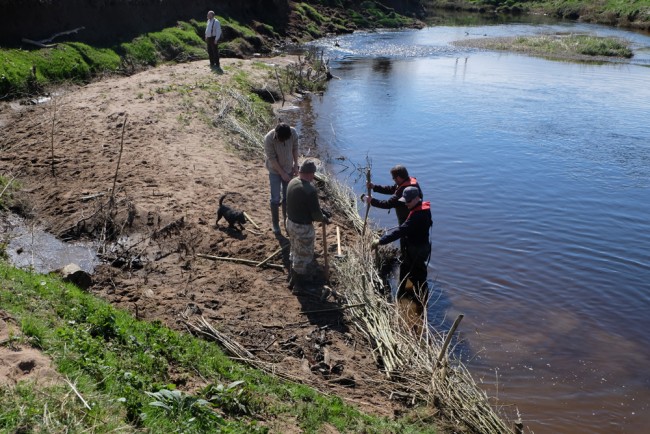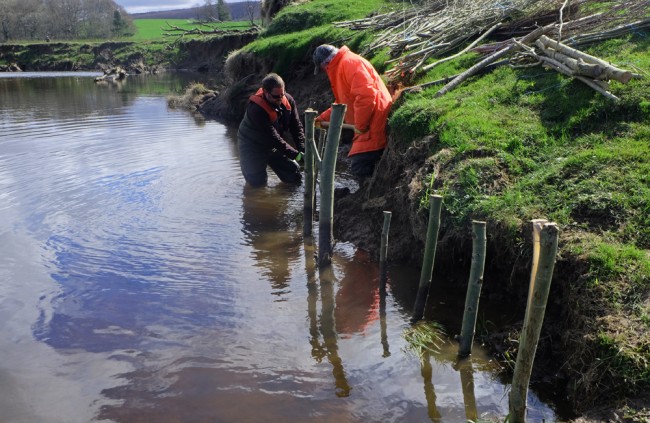2 years and one month on from when we first installed willow spiling at our green bank engineering sites on the Girvan, we have completed everything we planned to do and achieved almost all our intended results. The demonstration sites will continue to improve over the next few years and we will look back on this as a major achievement considering the scale of the problems that existed.

A more appealing alternative to rock armour and much cheaper too! Read about this project below and see how we’ve transformed severe erosion into a stable and diverse habitat that benefits wildlife and fish.
The Trust first suggested ways to resolve severe erosion on a wintery afternoon in November 2011. The landowners attempted a repair, loosely following our advice in 2013 and while this was a starting point, it wasn’t a complete success as several large trees dislodged from where they had been placed and to this day, they lie in the middle of the pool. The local syndicate also had a go with hazel spiling at the upper site and made a start on reducing erosion with limited success. Had they woven willow, I think they would have had much greater success. They also planted willow cuttings at the lower site that are doing very well towering above the woody debris and root balls that remained in place.

The upper site in 2015 where hazel spiling had started to trap sediment but as it doesn’t root, it quickly deteriorated and was in need of some assistance.

2015 Another view illustrating the severity of the erosion in 2015

2015 Spates soon moved trees from where a contractor had placed them in 2013 and they remain in mid stream today. The bank continued to erode at this point prompting ART to look for a more effective solution
In April 2016, we set about installing green bank engineering with our volunteers. We spent a morning weaving willow into the bottom erosion scar and installing willow faggots at the upper site. We also planted hundreds of willow cuttings across both areas.

April 2016. Installing willow faggots (bundles) staked into the top of the previously installed Hazel spilling. Willow cuttings were planted across the area.

April 2016. Driving willow stakes into the river bed around which willow spiling was woven.
Over the remainder of 2016, we were pleased to see the willow was growing and had obviously rooted well. In spring 2017 we returned to find the sheep had eaten most of the cuttings and urged the landowners to fence the site to keep grazing animals off the banks. There was no doubt in our minds that excluding livestock was essential for success. We replanted willows and installed 30- 40m of brash bundles to reinforce the upper bank to trail another method. More willow stakes were used to hold these in place. Again we watched as our work matured and all looked promising.
In spring 2018, two fences were erected around the erosion points and we linked them to the water’s edge with experimental living willow stakes and brash to exclude sheep. We used this method as the landowner was concerned that they would loose their fence to spates if it went to the water’s edge. 2 months later and the sheep have been moved out until silage is cut but when they were there, our fences seemed to do the trick. The bank are thick with plants and our trees and willows are thriving. Just compare how these sites looked today with earlier photos.

2018 The upper site is covered with lush growth and our willow faggots have developed into a thick hedge at the water’s edge. This will prevent further erosion at this pont and allow the bank behind to recover

2018 Almost the same view as the image taken in April 2016 of ART and volunteers installing willow faggots. the change in such a short time is remarkable. It is almost unrecognisable as the same location

2018 This image is of the lower erosion point. Willows are developing since the sheep were excluded. The constantly eroding banks have vegetated and are now stable. The tree in the river gives a reference point to compare with the photo from 2015

June 2018 Compare this with the image of ART and volunteers installing this spilling 2 years ago. We’ve already taken a load of cuttings from this section to boost the willows along the banks.

Looking downstream from the top end of the lower erosion point. Our living brash and willow barrier links the fence to the waters edge keeping lambs and livestock from the river bank.

A close up of a living and rustic fence to link traditional livestock fencing to the river’s edge. If this washes out in a spate, it should be simple to repair with freely available materials. It should be firmly rooted by next winter so may stand up to spate conditions well
There’s plenty more erosion to tackle on the Girvan but this is a demonstration of what can be achieved using living materials rather than rock armour if you know what you are doing and use the right materials. We are certain, these techniques are far more beneficial to the ecology and cost effective when compared to traditional hard engineering methods.
Anyone that would like to visit this site or requires advice on how green bank engineering may be of benefit on their river banks should contact the Trust. We would be very pleased to be of assistance if we can.

